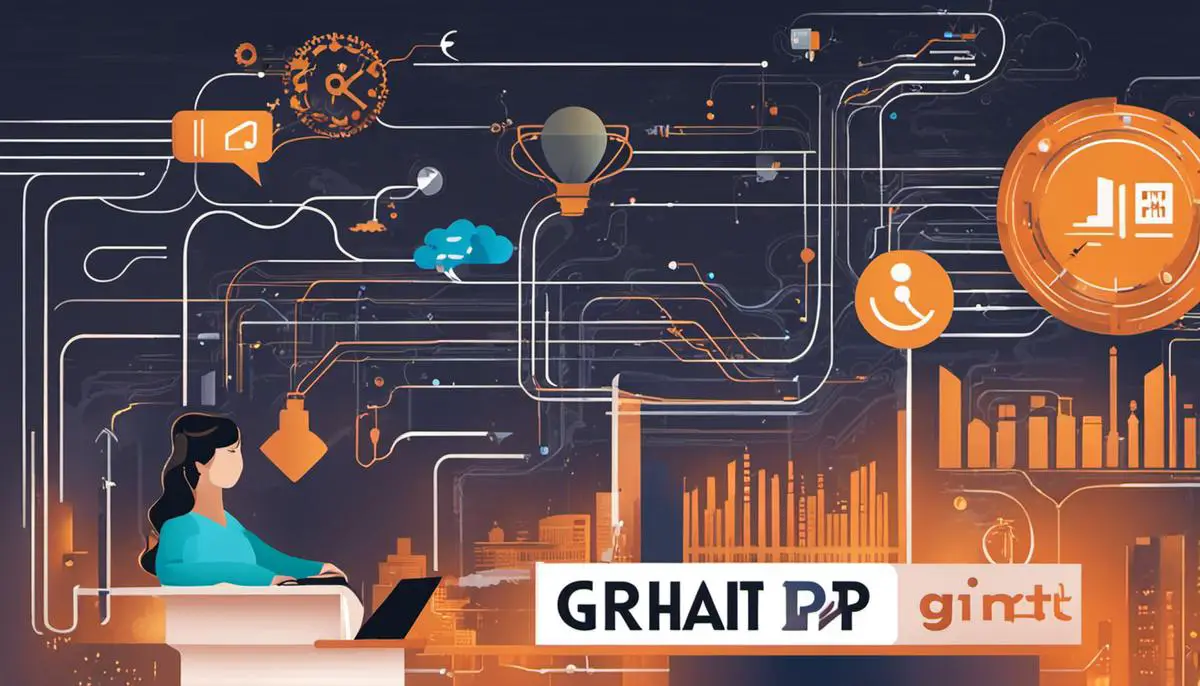As technology continues to rapidly evolve, an emergent pillar in the field is the Generative Pretrained Transformer (GPT) model, predominantly recognized in contemporary conversational applications. This technology, hailed for its linguistic abilities, is rooted deeply in the fields of Natural Language Processing (NLP) and machine learning.
The ability to converse like a human has sparked significant interest in understanding and refining GPT models. Our journey begins by diving into the world of Chat GPT, evaluating its inner workings, understanding its foundational basis, and discovering practical applications.
Understanding Chat GPT
Table of Contents
Decoding Chat GPT: A Deep Dive Into AI Conversational Models
AI or Artificial Intelligence continues to advance at an astonishing pace. And today, the spotlight is shining brightly on Chat GPTs. These language prediction models are setting benchmarks for engagement in AI conversations. But what exactly is a Chat GPT and how does it function? Let’s delve deeper to understand better.
Chat GPT, acronymous for Generative Pretraining Transformer, is an AI-powered model developed by OpenAI. Essentially, Chat GPT is a text bot that interacts with users in the most human-like manner conceivable. It is proficient in both answering queries and also carrying on organic conversations.
This exceptional bot uses machine learning to predict and generate responses. It’s not just about spewing prepared answers to programmed questions. Chat GPT has the prowess to understand the context, recognize a user’s tone, mull over prior interactions, and respond accordingly.
The magic behind Chat GPT is the training process called Transformers. This machine learning model allows the bot to handle longer-range dependencies in conversations. It can connect and interpret various components, often with subtler nuances, all thanks to its sophisticated self-attention mechanism.
Key to understanding how Chat GPT works is the concept of GPT or Generative Pretraining. During the pretraining phase, GPT utilizes a vast array of internet text, learning to predict the next word in a sentence. It gleans patterns, structures, and even idioms in the text, leading to surprising fluency.
After this initial pretraining, the model is fine-tuned. It’s here that GPT learns to generate more specific and targeted responses. Human trainers guide the model using a process called Reinforcement Learning from Human Feedback (RLHF), tweaking it further to interact more effectively with users.
But is Chat GPT infallible? Simply put, no. As state-of-art as it is, Chat GPT is not perfect. It might occasionally write nonsensical or inappropriate responses. It’s also vulnerable to biases, a reflection of the data it was trained on. Moreover, privacy could be a concern, as it’s trained to forget specific user interactions but retains generalized learnings.
Chat GPT, despite the challenges it grapples with, is a colossal stride in the realm of conversational AI. It’s the testament of continuous learning and evolving technology.
The bottom line is this: understanding Chat GPT requires a careful dip into the deep waters of AI, talking about biases, fine-tuning, the Transformers model, and reinforcement learning. It’s a fascinating area, serving as a springboard for further developments in the world of AI. And while there is still a long journey ahead, there’s no denying the extraordinary capabilities of Chat GPT and the incredible potential it heralds for the future.

Adapting GPT’s Output to Mimic Human Conversations
The quest to humanize AI’s responses in tools like Chat GPT is a constant challenge on the AI frontier. However, there are several strategies and techniques that can help make GPT’s responses more human-like.
First, optimize language modeling. A language model used in Chat GPT predicts the likelihood of a word following a series of words. To make this model more effective, you can incorporate context-specific vocabulary to the existing data corpus. This sort of tailoring generates responses that better reflect the way humans speak.
Next is augment data to tackle a biased view. Since GPT inherits the bias present in its input data, it is essential to diversify training materials to incorporate different perspectives, jargons, and narratives. By expanding the pool of learning materials, GPT can become more versatile and reflect a fuller range of human responses.
Simply put, the simulator can utilize real-life conversations as a blueprint for constructing dialogues. By incorporating daily, casual interactions into the dataset, Chat GPT can learn to respond more naturally and situationally.
The next strategy is around perfecting the iterated learning approach. This refers to a cycle where models learn a task, produce outputs, and then the people rate these outputs to form a new dataset. The model learns again from this new dataset in a repeated cycle. By mastering this method, a model can achieve typically human-like responses in an interactive conversation.
A key resource is human feedback, playing a vital role in fine-tuning. Feeds from user interactions refine the behavioral aspects of models, hence contributing to their human attributes. While selecting a diverse range of feedback, ensure to account for regional dialects, slangs, and different socio-cultural contexts.
Another important consideration is to limit verbosity. Chat GPT can sometimes provide more information than required. Setting a word limit or designing the model in such a way that it provides precise and concise responses will enhance its human-like character.
Last but certainly not least, empathy is something that can significantly amplify the humanness of a response. Although this might seem a bit challenging, adjusting the model to detect and respond adequately to the sentiments implied within a conversational context can prod GPT responses towards mirrored human responses.
To conclude, by adapting these methods, we can inch closer to improving the human-likeness of GPT responses substantially. Moving from robotic, generic responses to human-like, contextually relevant interactions is a process that requires time and care. It’s an exciting journey, and there’s no doubt that with continuous research and development, we’re well on our way to bridging that gap.

Refining Chat GPT Error Handling
Effective error handling is a crucial facet of optimizing GPT for maximized authenticity.
To accomplish this feat, there are several key techniques:
- Implementing Context-History Tracking:
- Context-history tracking is about maintaining an understanding of the past exchange in the conversation. It helps avoid unanticipated responses by providing crucial context to the GPT model, measuring relevance and coherence of a generated response to the previously received input. This technique can significantly reduce semantic or logical errors in conversation.
- Context-history tracking is about maintaining an understanding of the past exchange in the conversation. It helps avoid unanticipated responses by providing crucial context to the GPT model, measuring relevance and coherence of a generated response to the previously received input. This technique can significantly reduce semantic or logical errors in conversation.
- Fine-Tuning Output with Post-Processing:
- Just as a sculptor chips away flaws on a finished sculpture, implementing post-processing techniques can fine-tune the initial GPT-generated outputs. This involves designing filters to remove or replace problematic content, create politeness and respect boundaries, or add other linguistic nuances. However, the trick here is to apply this technique selectively to prevent over-smoothing of conversational outputs.
- Just as a sculptor chips away flaws on a finished sculpture, implementing post-processing techniques can fine-tune the initial GPT-generated outputs. This involves designing filters to remove or replace problematic content, create politeness and respect boundaries, or add other linguistic nuances. However, the trick here is to apply this technique selectively to prevent over-smoothing of conversational outputs.
- Continuous and Dynamic Learning:
- In AI, learning should never stop. Continually feeding the GPT model with new data and experiences can enhance its accuracy over time. This is achieved by monitoring the errors flagged by users and updates to the model’s knowledge, which is a hybrid of supervised and reinforcement learning systems.
- In AI, learning should never stop. Continually feeding the GPT model with new data and experiences can enhance its accuracy over time. This is achieved by monitoring the errors flagged by users and updates to the model’s knowledge, which is a hybrid of supervised and reinforcement learning systems.
- Integration of Knowledge Graphs:
- Integrating knowledge graphs into the conversational AI framework allows the system to pull contextual information from structured data. This can greatly minimize factual errors and increase the overall knowledge base of the Chat GPT. An advantage of this technique is its compatibility with the transformer-based architecture of GPT.
- Integrating knowledge graphs into the conversational AI framework allows the system to pull contextual information from structured data. This can greatly minimize factual errors and increase the overall knowledge base of the Chat GPT. An advantage of this technique is its compatibility with the transformer-based architecture of GPT.
- Promoting Adaptive Response Generation:
- Chat GPT needs to adapt its responses based on the input context. Thus, mechanisms need to be built that facilitate adaptive response generation. This can greatly reduce inappropriate, inconsistent, or irrelevant responses from the bot.
- Chat GPT needs to adapt its responses based on the input context. Thus, mechanisms need to be built that facilitate adaptive response generation. This can greatly reduce inappropriate, inconsistent, or irrelevant responses from the bot.
- Developing Comprehensive Safety Measures:
- Safety measures are essential to prevent the model from generating harmful, toxic, or objectionable content. This involves incorporating robust content filters and community guidelines. In addition, setting up an offensive content review system with human intervention would be effective.
Remember, GPT is a powerful tool—an autonomous, text-generating marvel powered by advanced AI. Its error management and improvements hinge on constantly fine-tuned learning processes. Building upon the foundation of GPT’s comprehensively trained transformer-based models, these techniques can help mould and enhance high-quality, interactive, and importantly, safer conversational AI.
The essence of indistinguishable chatbot conversations embarks toward the sophisticated amalgamation of a myriad of techniques. It stems not only from proficient handling of errors but also the deftness in mimicking human-like nuances, slang, and colloquial language, and maintaining the apt contextuality and diversity in response length.
By refining and advancing these techniques, we are stepping closer to erasing the thin line between human and AI conversation, entirely harnessing the power of GPT in the real world. A sense of ingenuity in every response is the future of GPT models, enabling them to seamlessly blend into the human communication fabric.

I’m Dave, a passionate advocate and follower of all things AI. I am captivated by the marvels of artificial intelligence and how it continues to revolutionize our world every single day.
My fascination extends across the entire AI spectrum, but I have a special place in my heart for AgentGPT and AutoGPT. I am consistently amazed by the power and versatility of these tools, and I believe they hold the key to transforming how we interact with information and each other.
As I continue my journey in the vast world of AI, I look forward to exploring the ever-evolving capabilities of these technologies and sharing my insights and learnings with all of you. So let’s dive deep into the realm of AI together, and discover the limitless possibilities it offers!
Interests: Artificial Intelligence, AgentGPT, AutoGPT, Machine Learning, Natural Language Processing, Deep Learning, Conversational AI.






